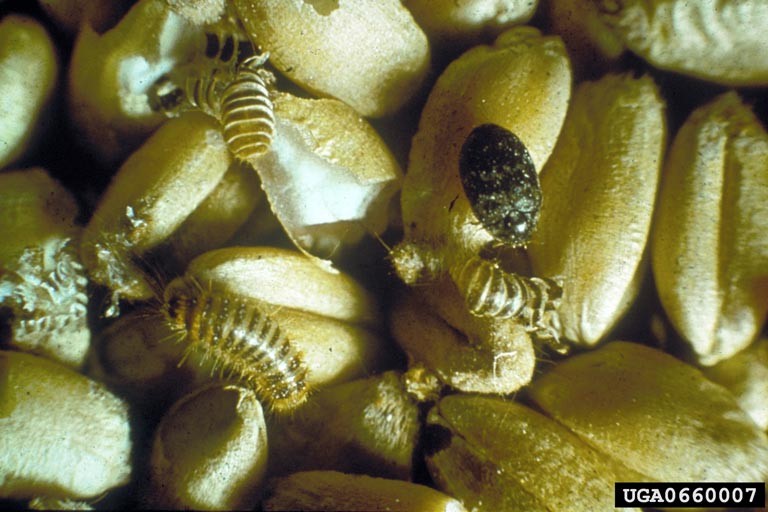Trogoderma granarium
Khapra Beetle
Synonyms: Trogoderma affrum
Class: Insecta
Order: Coleoptera
Family: Dermestidae

Photographer: Ministry of Agriculture and Regional Development Archive
Source: Bugwood.org
Adult Description: These brown beetles are oval had have yellowish-brown to reddish-brown transverse stripes on the elytra and are covered with fine hairs. Males from to 2mm long and females are up to 3mm long.
Larvae Description: The larvae are yellowish-brown and spindle-shaped that grow up to 5mm in length. Also, they have characteristic, thick and reddish brown hairs that grow on the posterior end of the larvae.
Host Plant: Prefers wheat, barley and rice; but the larvae have been found on: oats, rye, corn, dried milk, fishmeal, flour, bran, malt, flax and alfalfa seed, pinto beans, spaghetti noodles, lima beans, lentils, peanuts, wheat germ and many more.
Ecological Threat: Trogoderma granarium is considered one of the world’ most destructive pests of grain products and seeds. The larval stage is the most detrimental. It can be found in warehouses, mills, breweries and malt factories. This is because it attacks all types of grain. The grain kernels are often hollowed out leaving nothing but the husk behind. Also, this beetle can reproduce so rapidly that binned grain can become flooded with larvae, completely destroying all of the crop. With a wide host range of several economically important crops this insect poses a very serious threat to crops in the United States; which is why serious surveying and maintenance has occurred to prevent this insect from re-establishing itself here.
Biology: Adult khapra beetles are not long lived; mated females last up to 5 days while unmated females can last 30 days and males from one week to 12 days. Mating occurs 5 days after emerging from pupation and egg laying occurs right after mating. Complete development from egg to adult depends on temperature and can last anywhere from 26 to 220 days.
History: First discovered in California in 1953, since then it had been repeatedly intercepted at ports or country boundaries by customs. Usually in seed or grain shipments. It has been successfully eradicated from each state it has been found.
U.S. Habitat: Prefers hot and dry conditions and can be found in areas where grains and other potential foods are stored.
Distribution
Native Origin: India
U.S. Present: Right now, eradicated from the U.S. but has been found in AZ, CA, CT, MD and MN
Resembles/Alternatives
The larvae can resemble other beetles in the genus Trogoderma, those of which are not an economical concern. Larvae and adults are best identified by microscopic examination.
Management
The only reason this insect has been eradicated from sites it was found is due to vigilant surveying and rapid responses. USDA-APHIS inspects cargo ships and cargo from khapra beetle infested areas and warehouses containing cargo from those areas. These beetles can be detected by examining cracks and crevices and inspecting paneling on walls and under timbers, tanks or shelves. Some fumigants do work but high concentrations of fumigant must be maintained over the fumigation period so that penetration into all crevices can occur. To eradicate, both fumigants and surface sprays are used in combination with good sanitation practices.
References
Lindgren DL, Vincent LE. 1959. Biology and control of Tragoderma granarium Everts. Journal of Economic Entomology 52:312-319.
Internet Sources
http://pest.ceris.purdue.edu/pest.php?code=INATANA
http://www.agri.idaho.gov/Categories/PlantsInsects/RegulatedAndInvasiveInsects/Documents/Khapra%20Beetle11.pdf
http://edis.ifas.ufl.edu/in667
http://extension.entm.purdue.edu/CAPS/pestInfo/khapra.htm
 Texas Invasive Species Institute
Texas Invasive Species Institute